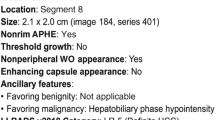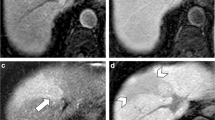Abstract
Purpose
Liver Imaging Reporting and Data System (LI-RADS) uses major features (arterial phase hyperenhancement [APHE], “washout” [WO], “capsule,” diameter, threshold growth [TG]) to codify probability of hepatocellular carcinoma for each observation. This study assessed the effect of removing TG as a major feature on LI-RADS categorization.
Materials and methods
In this HIPAA-compliant, IRB-approved study, all MR and CT clinical reports containing a standardized LI-RADS v2014 template between 4/15–1/17 were retrospectively reviewed for each LR-3, LR-4, and LR-5 reported observation. Two LI-RADS categories were then assigned: one using all LI-RADS major features and one after removing TG as a major feature. The two categories were compared descriptively.
Results
The study included 265 patients (172 [65%] male, mean age 63 [±10] years) with 489 observations (median diameter 14 mm, IQR 10–20 mm), of which 345 (71%) had APHE, 307 (63%) had WO, 86 (18%) had “capsule,” and 72 (15%) had TG. Of 86 observations with TG, 47 (65%) were new observations ≥10 mm, 14 (19%) had diameter increase ≥50% in ≤6 months, and 11 (15%) had diameter increase ≥100% in >6 months. Using all major features, 214/489 (44%) observations were LR-3, 129/489 (26%) were LR-4, and 146/489 (30%) were LR-5. After removing TG, 237/489 (48%) were LR-3, 119/489 (24%) were LR-4, and 133 (27%) were LR-5. Removing TG caused a category downgrade for 35/489 (7%, 95% CI 5–10) observations, including 13/146 (9%, 95% CI 3–14) LR-5 observations.
Conclusion
9% of LR-5 observations would be downgraded without TG.








Similar content being viewed by others
References
Tang A, Valasek MA, Sirlin CB (2015) Update on the liver imaging reporting and data system: what the pathologist needs to know. Adv Anat Pathol 22(5):314–322
Santillan CS, Tang A, Cruite I, Shah A, Sirlin CB (2014) Understanding LI-RADS: a primer for practical use. Magnet Reson Imaging Clin N Am 22(3):337–352
American College of Radiology: Liver imaging reporting and data system. (2014) http://nrdr.acr.org/lirads/.
Shah A, Tang A, Santillan C, Sirlin C (2016) Cirrhotic liver: what’s that nodule? The LI-RADS approach. J Magn Reson Imaging. 43(2):281–294
Wald C, Russo MW, Heimbach JK, et al. (2013) New OPTN/UNOS policy for liver transplant allocation: standardization of liver imaging, diagnosis, classification, and reporting of hepatocellular carcinoma. Radiology 266(2):376–382
Bruix J, Sherman M (2005) Management of hepatocellular carcinoma. Hepatology 42(5):1208–1236
Bruix J, Sherman M (2011) Management of hepatocellular carcinoma: an update. Hepatology 53(3):1020–1022
European Association for the Study of the Liver (2012) EASL-EORTC clinical practice guidelines: management of hepatocellular carcinoma. J Hepatol 56(4):908–943
Omata M, Lesmana LA, Tateishi R, et al. (2010) Asian Pacific Association for the Study of the Liver consensus recommendations on hepatocellular carcinoma. Hepatol Int 4(2):439–474
Kudo M, Matsui O, Izumi N, et al. (2014) JSH consensus-based clinical practice guidelines for the management of hepatocellular carcinoma: 2014 update by the liver cancer study group of Japan. Liver Cancer. 3(3–4):458–468
Lee JM, Park JW, Choi BI (2014) 2014 KLCSG-NCC Korea Practice Guidelines for the management of hepatocellular carcinoma: HCC diagnostic algorithm. Dig Dis. 32(6):764–777
Kim TK, Lee KH, Jang HJ, et al. (2011) Analysis of gadobenate dimeglumine-enhanced MR findings for characterizing small (1-2-cm) hepatic nodules in patients at high risk for hepatocellular carcinoma. Radiology 259(3):730–738
Rimola J, Forner A, Tremosini S, et al. (2012) Non-invasive diagnosis of hepatocellular carcinoma ≤2 cm in cirrhosis. Diagnostic accuracy assessing fat, capsule and signal intensity at dynamic MRI. J Hepatol 56(6):1317–1323
Valls C, Cos M, Figueras J, et al. (2004) Pretransplantation diagnosis and staging of hepatocellular carcinoma in patients with cirrhosis: value of dual-phase helical CT. AJR Am J Roentgenol 182(4):1011–1017
Laghi A, Iannaccone R, Rossi P, et al. (2003) Hepatocellular carcinoma: detection with triple-phase multi-detector row helical CT in patients with chronic hepatitis. Radiology 226(2):543–549
Choi JW, Lee JM, Kim SJ, et al. (2013) Hepatocellular carcinoma: imaging patterns on gadoxetic acid-enhanced MR Images and their value as an imaging biomarker. Radiology 267(3):776–786
Matsui O (2004) Imaging of multistep human hepatocarcinogenesis by CT during intra-arterial contrast injection. Intervirology 47(3–5):271–276
Matsui O, Kobayashi S, Sanada J, et al. (2011) Hepatocelluar nodules in liver cirrhosis: hemodynamic evaluation (angiography-assisted CT) with special reference to multi-step hepatocarcinogenesis. Abdom Imaging 36(3):264–272
Ishigami K, Yoshimitsu K, Nishihara Y, et al. (2009) Hepatocellular carcinoma with a pseudocapsule on gadolinium-enhanced MR images: correlation with histopathologic findings. Radiology 250(2):435–443
Khan AS, Hussain HK, Johnson TD, et al. (2010) Value of delayed hypointensity and delayed enhancing rim in magnetic resonance imaging diagnosis of small hepatocellular carcinoma in the cirrhotic liver. J Magn Reson Imaging 32(2):360–366
Forner A, Vilana R, Ayuso C, et al. (2008) Diagnosis of hepatic nodules 20 mm or smaller in cirrhosis: Prospective validation of the noninvasive diagnostic criteria for hepatocellular carcinoma. Hepatology 47(1):97–104
Ohkawa K, Imanaka K, Sakakibara M, et al. (2014) Factors related to shift from hepatic borderline lesion to overt HCC diagnosed by CT. Hepato Gastroenterol 61(134):1680–1687
Bolondi L, Gaiani S, Celli N, et al. (2005) Characterization of small nodules in cirrhosis by assessment of vascularity: the problem of hypovascular hepatocellular carcinoma. Hepatology 42(1):27–34
Mitchell DG, Bruix J, Sherman M, Sirlin CB (2015) LI-RADS (Liver Imaging Reporting and Data System): summary, discussion, and consensus of the LI-RADS Management Working Group and future directions. Hepatology 61(3):1056–1065
Burke LM, Sofue K, Alagiyawanna M, et al. (2016) Natural history of liver imaging reporting and data system category 4 nodules in MRI. Abdom Radiol (NY) 41(9):1758–1766
Darnell A, Forner A, Rimola J, et al. (2015) Liver imaging reporting and data system with MR imaging: evaluation in nodules 20 mm or smaller detected in cirrhosis at screening US. Radiology 275(3):698–707
Choi SH, Byun JH, Kim SY, et al. (2016) Liver imaging reporting and data system v2014 with gadoxetate disodium-enhanced magnetic resonance imaging: validation of LI-RADS category 4 and 5 criteria. Investig Radiol 51(8):483–490
Tamada T, Korenaga M, Yamamoto A, Higaki A, Kanki A, Nishina S, et al. (2016) Assessment of clinical and MRI features of de novo hypervascular HCC using gadoxetic acid-enhanced MRI. Hepatol Res
Jeong YY, Mitchell DG, Kamishima T (2002) Small (<20 mm) enhancing hepatic nodules seen on arterial phase MR imaging of the cirrhotic liver: clinical implications. AJR Am J Roentgenol 178(6):1327–1334
Sadek AG, Mitchell DG, Siegelman ES, et al. (1995) Early hepatocellular carcinoma that develops within macroregenerative nodules: growth rate depicted at serial MR imaging. Radiology 195(3):753–756
Nakajima T, Moriguchi M, Mitsumoto Y, et al. (2002) Simple tumor profile chart based on cell kinetic parameters and histologic grade is useful for estimating the natural growth rate of hepatocellular carcinoma. Hum Pathol 33(1):92–99
Kojiro M (2010) Pathological diagnosis at early stage: reaching international consensus. Oncology. 78(Suppl 1):31–35
Silva MA, Hegab B, Hyde C, et al. (2008) Needle track seeding following biopsy of liver lesions in the diagnosis of hepatocellular cancer: a systematic review and meta-analysis. Gut 57(11):1592–1596
Sofue K, Sirlin CB, Allen BC, et al. (2016) How reader perception of capsule affects interpretation of washout in hypervascular liver nodules in patients at risk for hepatocellular carcinoma. J Magn Reson Imaging 43(6):1337–1345
Davenport MS, Khalatbari S, Liu PS, et al. (2014) Repeatability of diagnostic features and scoring systems for hepatocellular carcinoma by using MR imaging. Radiology 272(1):132–142
Bashir MR, Huang R, Mayes N, et al. (2015) Concordance of hypervascular liver nodule characterization between the organ procurement and transplant network and liver imaging reporting and data system classifications. J Magn Reson Imaging 42(2):305–314
Corwin MT, Fananapazir G, Jin M, Lamba R, Bashir MR (2016) Differences in Liver Imaging and Reporting Data System Categorization Between MRI and CT. AJR Am J Roentgenol 206(2):307–312
Zhang YD, Zhu FP, Xu X, et al. (2016) Liver imaging reporting and data system: substantial discordance between CT and MR for imaging classification of hepatic nodules. Acad Radiol 23(3):344–352
Author information
Authors and Affiliations
Corresponding author
Ethics declarations
Funding
No funding was received for this study.
Conflict of interest
V. Chernyak, M. Kobi, M. Flusberg, K.C. Fruitman have no conflict of interest. C.B. Sirlin: Industry grant support—Siemens, GE, Guerbet; Consulting and service agreements—Bracco, Alexion, AstraZeneca, Bioclinica, BMS, Fibrogen, Galmed, Genentech, Genzyme, Gilead, Icon, Intercept, Isis, Janssen, NuSirt, Perspectum, Pfizer, Profil, Sanofi, Shire, Synageva, Tobira, Takeda, Virtual Scopics
Ethical approval
All procedures performed in studies involving human participants were in accordance with the ethical standards of the institutional and/or national research committee and with the 1964 Helsinki declaration and its later amendments or comparable ethical standards.
Informed consent
The requirement for the informed consent was waived by the Institutional Review Board.
Rights and permissions
About this article
Cite this article
Chernyak, V., Kobi, M., Flusberg, M. et al. Effect of threshold growth as a major feature on LI-RADS categorization. Abdom Radiol 42, 2089–2100 (2017). https://doi.org/10.1007/s00261-017-1105-8
Published:
Issue Date:
DOI: https://doi.org/10.1007/s00261-017-1105-8




